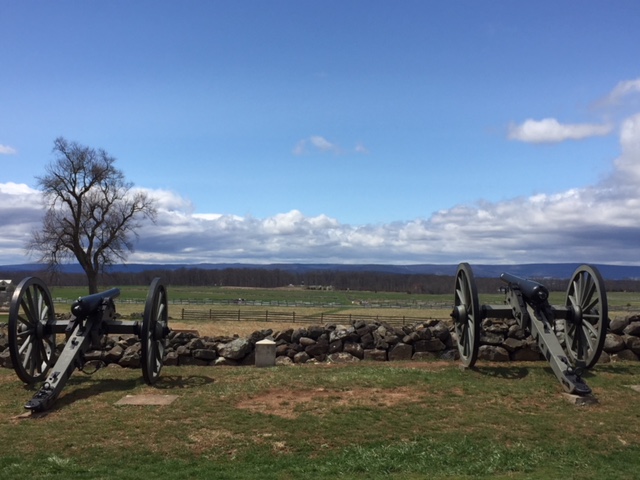Gettysburg, Pennsylvania
Wednesday, April 18, 2018
Clear, 56°
“Perhaps travel cannot prevent bigotry, but by demonstrating that all peoples cry, laugh, eat, worry, and die, it can introduce the idea that if we try and understand each other, we may even become friends” – Maya Angelou
The areas around Gettysburg, Pennsylvania and Antietam, Maryland saw some of the bloodiest conflicts during the Civil War.
Driving around Gettysburg National Military Park is a fascinating and moving experience. You’ve heard the stories or read about it in school but until you can actually go all over the miles of different battlefields where the skirmishes and main battles were fought there is no sense of scale. The three day battle effectively settled the Civil War even though fighting would continue for another two years.
In May 1863, Robert E. Lee’s Confederate Army of Northern Virginia had scored a smashing victory over the Army of the Potomac at Chancellorsville. Brimming with confidence, Lee decided to go on the offensive and invade the North for a second time (the first invasion had ended at Antietam the previous fall). In addition to bringing the conflict out of Virginia and diverting northern troops from Vicksburg, where the Confederates were under siege, Lee hoped to gain recognition of the Confederacy by Britain and France and strengthen the cause of northern “Copperheads” who favored peace.
In the summer of 1863, Confederate Gen. Robert E. Lee launched his second invasion of the Northern states. Lee sought to capitalize on recent Confederate victories and defeat the Union army on Northern soil, which he hoped would force the Lincoln administration to negotiate for peace. Lee also sought to take the war out of the ravaged Virginia farmland and gather supplies for his Army of Northern Virginia.
Using the Shenandoah Valley as cover for his army, Lee was pursued first by Union Maj. Gen. Joseph Hooker, and then by Maj. Gen. George G. Meade, who replaced Hooker in late June. Lee's army crossed into Pennsylvania mid-June and by June 29th had reached the Susquehanna River opposite Harrisburg and at Wrightsville.
The opposing forces collided at the crossroads town of Gettysburg, Pennsylvania, on the morning of July 1st. In severe fighting, the Confederates swept the Federals from the fields west and north of town, but were unable to secure Cemetery Hill and Culp's Hill to the south. The following day, as reinforcements arrived on both sides, Lee attacked the Federals on the heights, and also Little Round Top further south, but failed to dislodge the defenders. On July 3rd, Lee attacked the Union center on Cemetery Ridge and was repulsed in what is now known as Pickett’s Charge. Lee's second invasion of the North had failed, and had resulted in heavy casualties on both sides. An estimated 51,000 soldiers were killed, wounded, captured, or listed as missing after the Battle of Gettysburg. (Information Source – Civil War Trust)
It was a mostly windless day today and in several places in the battlefields you could still smell the gunpowder around you. It was an eerie sense to what happened here so many years ago. To stand on the hill where Gen. Lee watched Picket’s Charge and seeing 15,000 men charging across a mile wide field with the Union soldiers waiting for them on Cemetery Ridge behind a low wall is something to see. It saddens the heart to know that less than 6,000 returned after the failed attempt to take Cemetery Ridge. This was late in the third day of fighting.
Standing atop Little Round Top and looking down at Devils Den is pretty amazing knowing the fighting had been all around you both on top of the hill and down in the Den. Every battlefield felt the same way. The town and the veterans who created this National Military Monument is a testament to those who lost lives on both sides of this campaign. Three days of fierce fighting, heavy losses on both sides, those killed in action, wounded, or missing in action on this hallowed ground, standing there you can visualize the sights and sounds of these attacks and skirmishes. In places the smells of gunpowder still linger from the massive cannon volleys of artillery firing across these fields from both sides.
In November 1863, President Abraham Lincoln delivered his most famous speech at the dedication of the National Cemetery at Gettysburg, eloquently transforming the Union cause into a struggle for liberty and equality--in only 272 words.
